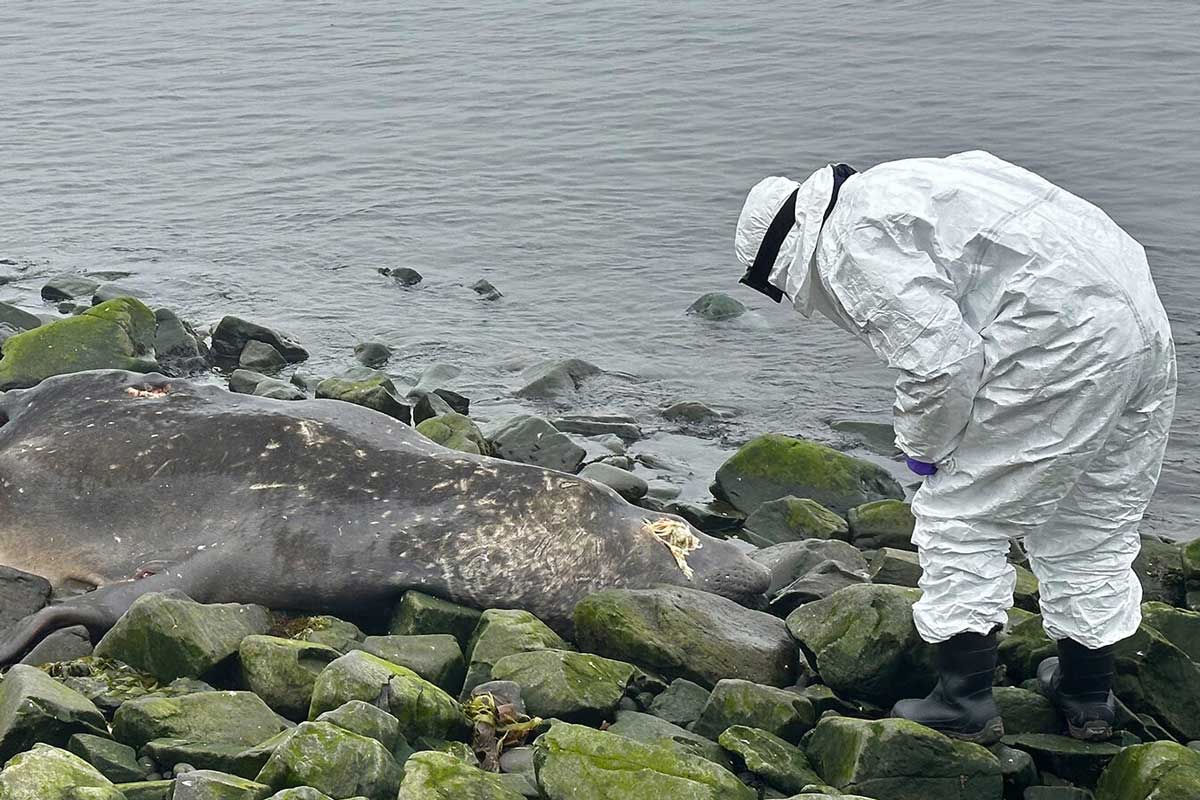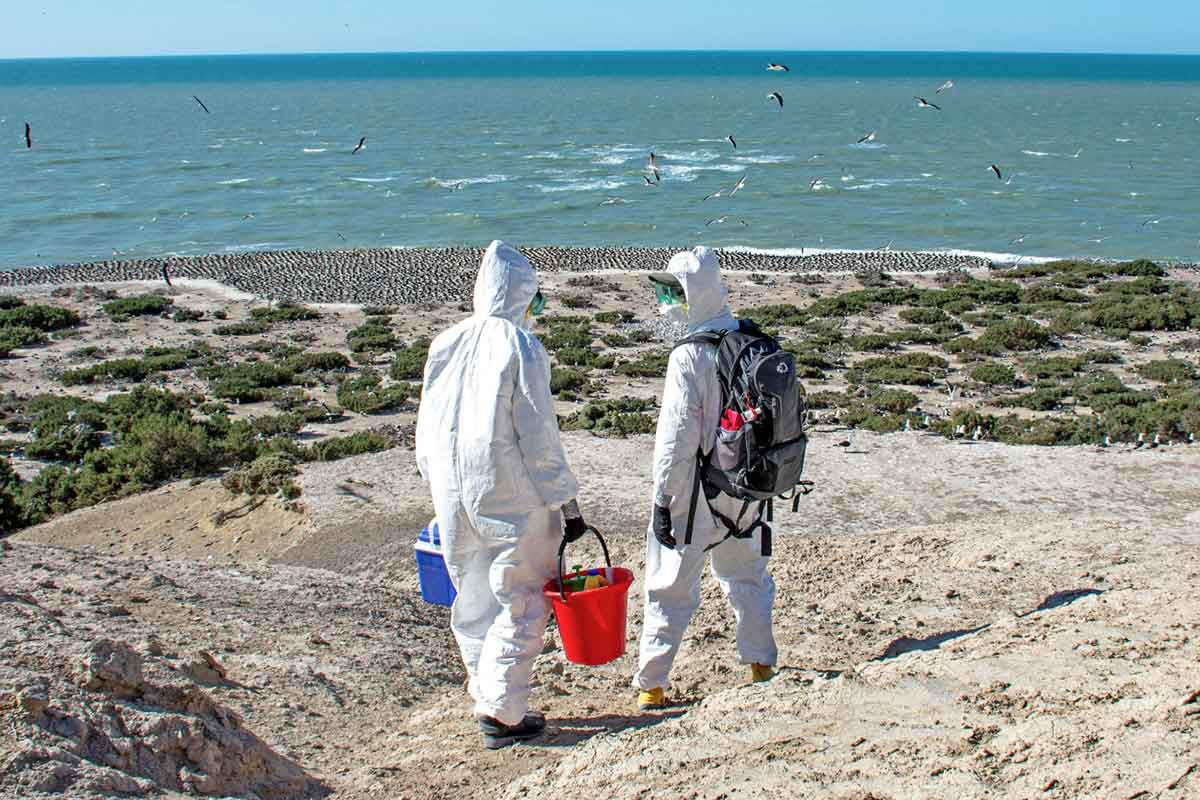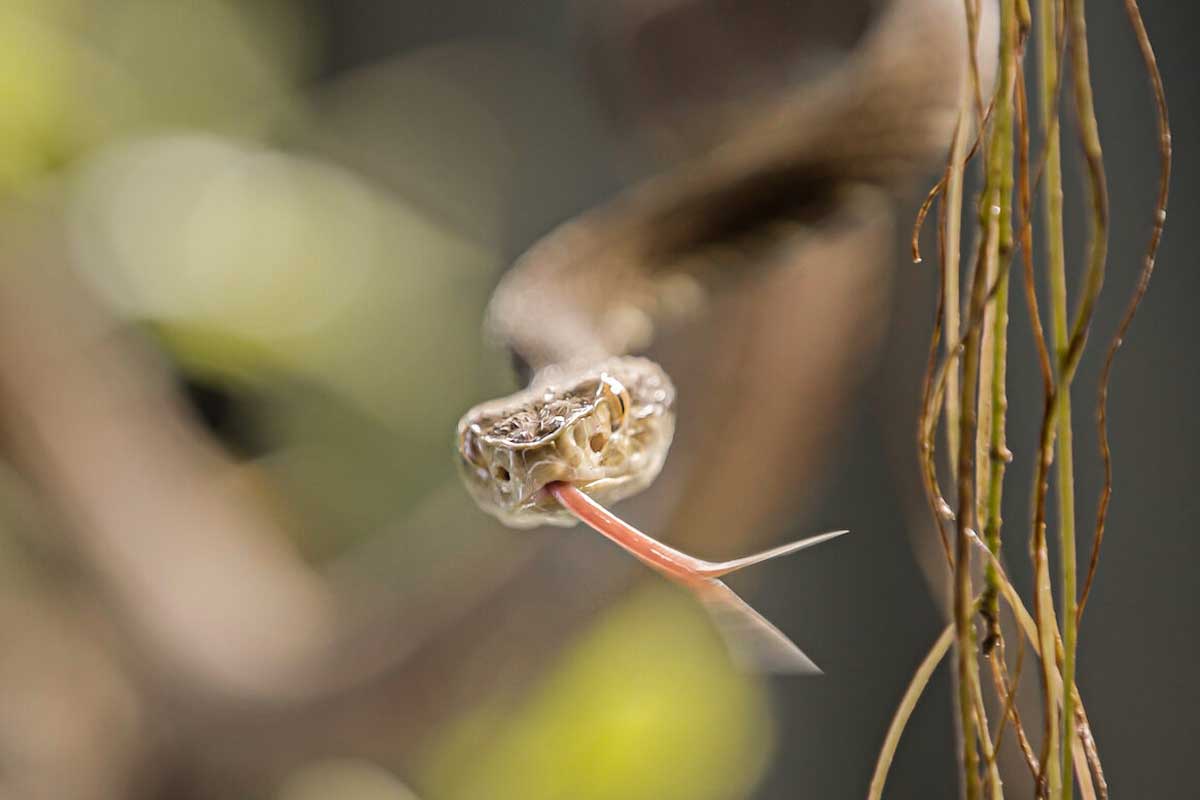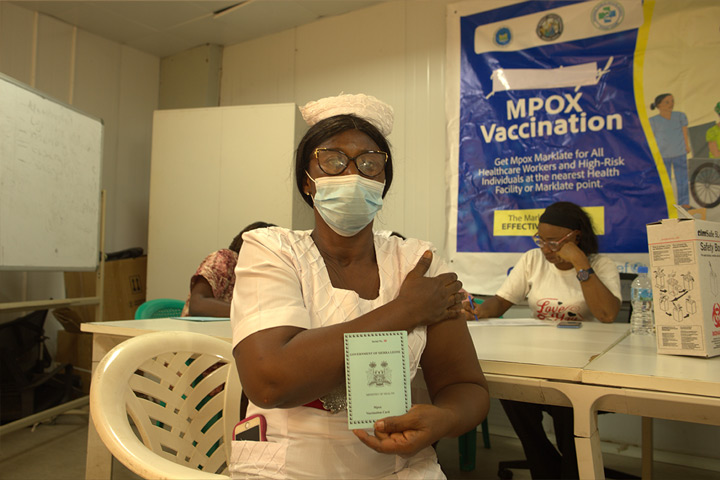How is bird flu affecting animal populations?
The world is currently seeing the fastest-spreading, largest-ever outbreak of H5N1, a highly contagious, deadly strain of avian influenza. Scientists say this virus now presents an existential threat to the world’s biodiversity, with the risk to humans rising as it continues to leap the species barrier, reaching new host species.
- 12 August 2024
- 16 min read
- by Mongabay

- H5N1 has already impacted at least 485 bird species and 48 mammal species, killing seals, sea otters, dolphins, foxes, California condors, albatrosses, bald eagles, cougars, polar bears and a zoo tiger. Since it broke out in Europe in 2020, this virus has spread globally. Carried by birds along migratory pathways, it has invaded six continents, including Antarctica.
- This current H5N1 animal pandemic (or panzootic) was caused by humans: A mild form of avian flu carried by wild birds turned deadly when it infected domestic poultry. Many industrial-scale poultry farms adjoin wetlands where migrating birds congregate, facilitating rapid spread.
- The toll on some bird and mammal populations has been devastating. With continued outbreaks, some imperiled species could be pushed to the brink, with wildlife already fighting to survive against a changing climate, disappearing habitat and other stressors.
Brown skuas and south polar skuas, two gull-like species that nest in Antarctica, are sometimes called the “pirates of the Southern seas.” These migratory seabirds are fierce, competitive predators that hunt or scavenge anything, from eggs and adult birds to seafood, mammals or garbage.
“They’re really tough animals — and they’re dying,” says Antonio Quesada, director of the Spanish Polar Committee.
He gravely recounts why this season’s field work in the Antarctic was like no other: A lethal strain of avian flu, H5N1, breached this fragile ecosystem in February. Only a handful of specially trained researchers were allowed onshore in outbreak sites, garbed in hazmat suits to prevent contagion and spread.
The true scale of the event is still unknown, but reports were grim. In the Falkland Islands, H5N1 killed 10,000 black-browed albatross and ravaged a gentoo penguin colony. Scientists discovered a mass skua die-off: 50 carcasses littered a Beak Island nesting colony of 130.
Quesada has rarely seen a single dead skua in 20 years’ work in Antarctica. “They’re an indicator species. If they’re dying, what does it mean for other birds?” he asks.
The threat posed by H5N1 extends far beyond the frozen South. Few people realize that the world is currently gripped in another serious pandemic — or, to be exact, a panzootic, the animal equivalent. This virus has now infected more than 500 bird and mammal species.

The world’s animals in trouble
Since it emerged in 2020 in Europe, this “Highly Pathogenic Avian Influenza (HPAI)” strain has blazed a trail of death across the planet, the largest outbreak in history. The virus is both lethal and unusually transmissible, jumping between birds, mammals and livestock with frightening agility.
Experts say the threat to humans is rising. Many countries are increasing surveillance and developing or buying vaccines. Cases are ticking up in the U.S.: Four people contracted the virus from cows and 10 others caught it from chickens.
Meanwhile, it continues to devastate wildlife, including many endangered animals, says Chris Walzer, executive director of health at the nonprofit Wildlife Conservation Society. As of March, H5N1 had leapt the species barrier to infect some 485 types of bird and at least 48 mammal species, according to United Nations estimates. Many of these species had never been diagnosed with avian influenza before.
The disease has infiltrated even the most remote regions on six continents. When a polar bear in Alaska succumbed in 2023, it marked the first detected mammal death from avian flu in the Arctic. Thus far, only Australia and the Pacific Islands have been spared. And the virus is still on the move, spreading to new hosts as it evolves and picks up genes from other bird flu strains.
Victims have died in staggering numbers, especially animals that congregate in large groups like pinnipeds. The virus swept along South America’s Atlantic and Pacific coastlines, slaying more than 30,000 sea lions in 2022-23. It then killed some 17,000 Southern elephant seal pups on Argentina’s Península Valdés — the species’ largest die-off ever.
H5N1 has been carried worldwide by migrating birds. But new research shows that this current strain (dubbed clade 2.3.4.4b) can now spread directly between mammals, with frightening implications. It seems that “H5N1 viruses are becoming more evolutionarily flexible and adapting to mammals in new ways,” the study’s authors write, which “could have global consequences for wildlife, humans, and/or livestock.”
Walzer warns, “H5N1 now presents an existential threat to the world’s biodiversity.”

A human-caused problem
It’s important to understand that this panzootic “is a man-made problem,” says Vincent Munster, who heads the Virus Ecology Section at the U.S. National Institute of Allergy and Infectious Diseases.
Avian flu is not uncommon in wild birds, particularly in its natural hosts: ducks, geese, gulls, terns, swans and other waterfowl. They carry a low pathogenic form, a mild virus that may be asymptomatic. It spreads seasonally, when multiple species congregate at migration stopover sites or cluster together to nest.
But when avian flu spills over into poultry, it can morph into a highly contagious, fatal virus.
The current panzootic began when this H5N1 strain jumped from domestic poultry back into wild birds — which happened because of modern livestock production methods. Humans further facilitated spillover by destroying wetlands, which crowds migrating birds into small scraps of habitat, often with poultry farms nearby.
When farms encroach wetlands, it creates the perfect interface for this type of virus, Walzer says. It’s a veritable petri dish of opportunity for avian flu to swap genes and mutate into potentially more virulent or transmissible strains. This environment allowed the virus to infect chickens, geese and ducks –– and jump back into the wild in a virulent form.
“The emergence of Highly Pathogenic Avian Influenza is a direct result of commercial, large-scale poultry farming,” Munster says. There are more than 34 billion chickens on Earth, according to Food and Agriculture Organization estimates.
The U.S. Delmarva Peninsula offers a prime example of farm-wetland overlap. It’s both a migratory stopover and a wintering ground along the North American flyway on the nation’s Mid-Atlantic coast. It’s also the site of a $4.4 billion poultry industry that raised 600 million chickens in 2023. H5N1 has hit there — and across the globe. In Cambodia, for example, farmers that raise their ducks and geese in wetlands have also seen outbreaks.
The virus is now spreading among cows, infecting at least 171 herds in 13 U.S. states. It thrives in udder cells, and RNA from H5N1 has been found in milk.
Another serious concern: H5N1 has not petered out between spring and fall migrations, like avian flu normally does. It’s now endemic in Europe and North America. When that happened, Walzer says, “people began worrying that it’s not going to go away anymore.”
It has flared for four years straight now, with wild birds currently carriers, reservoir hosts and victims of the virus.
Super-evolution: A brief history of a deadly global scourge
H5N1 isn’t new. In 1996, a goose in China’s Guangdong province may have been “patient zero” for the current strain, which spread among the flock and passed to wild birds. The virus then morphed into a severe respiratory disease that infected 18 people and killed six in Hong Kong. That outbreak ended after 1.5 million chickens were slaughtered.
Next came a “viral chatter” phase. Viruses don’t just break through species barriers. As they change, they make periodic forays into other species, sometimes over years. In most cases, these ventures are unsuccessful. Unless a virus can enter cells and replicate, it circulates harmlessly.
Flu viruses mutate rapidly as they acquire genes from other viruses: mixing, matching, reassorting and adapting, says Colin Ross Parrish, a virologist at Cornell University’s College of Veterinary Medicine. Each genetic mutation creates a new building block for evolution: Genetic sequences are cellular instructions. They help a virus evade immunity in a host, determine how it causes infection, how it spreads and much more.
Avian influenza’s eight-section genome offers numerous opportunities to reassort its genetics, not unlike a Las Vegas slot machine –– and in 2003, it hit a viral jackpot. Avian flu mutated to successfully spill back from poultry into wild birds, launching the current panzootic.
Fast forward to 2020 when H5N1 appeared in its current form in European birds and then successfully infiltrated new species, including mammals. It quickly spread to Africa and the Middle East, as it was carried long distances along migratory flyways. Humans helped by selling and shipping infected poultry across national borders.
The virus crossed the Atlantic, reaching U.S. and Canadian shores in late 2021. Soon, mallards and swans were dying in the U.S. Midwest, bald eagles died nationwide, seals perished in Maine, as did bobcats in Wisconsin and raccoons in Washington and Michigan, to name just a few of the many losses.
The virus then aggressively invaded South America, targeting birds and sea mammals. Genetic studies on dead seabirds, a dolphin and a sea lion in Peru shed light on H5N1’s movement and adaptations. Researchers discovered that in the U.S., the Eurasian strain added genes; in this form, it expanded its repertoire of hosts and raged like wildfire through large seal and sea lion colonies.
H5N1 finally reached both poles. Outbreaks continue to arise nearly everywhere.
Portrait of a global killer
Proximity is a big factor in how viruses spread, as the world learned during the COVID pandemic. Sharing a home or gathering in large groups poses a huge H5N1 risk, says Amandine Gamble, an infectious disease ecology expert at Cornell University’s College of Veterinary Medicine. To understand where birds go and how they spread H5N1, she is collecting genetic material from various species in the Falkland Islands and outfitting them with tracking devices to follow their movements.
Regardless of the location, the virus triggers a systemic infection in birds. They may become lethargic, sneezing, coughing, gasping for air or experiencing intestinal issues. The virus also invades the brain. Sick birds may become disoriented, uncoordinated, stumbling, swimming or walking in circles, trembling or jerking their necks before keeling over dead. Some suddenly die without showing any sign of illness. Survivors may pass the virus to others.
Mammals experience many of the same symptoms as birds, but postmortems have also revealed pneumonia and bleeding in the heart, liver and other organs. Autopsies of 55 mammals showed that the most commonly afflicted part of the brain was the frontal lobe, which explains the movement and cognitive symptoms.
The genie is out of the bottle, says Waltzer. He emphasizes that the length of the outbreak, as well as the amount of the virus in the environment, is unprecedented. “The sheer global distribution of this virus,” he notes, “is underestimated everywhere — as well as the breadth of ecosystems that are being impacted.”
Researchers are deeply concerned by the effects of this red-alert virus: “High pathogenicity H5N1 is a real, tangible threat to wildlife, of a magnitude and scale never seen before,” says Marcela Uhart, who heads the Latin American program at the University of California Davis’ One Health Institute.
On a United Nations situation update map, swaths of the world seem untouched, but that is likely because some regions have little or no monitoring for avian influenza, Walzer notes. For example, experts suspect there is vast underreporting in Africa. Many countries have slim resources, so pathogen hunters target the deadliest human threats: malaria. Ebola, Lassa fever and other infectious diseases.
Incomprehensible carnage
Many pathogens, including avian influenza, are zoonotic: They jump between wildlife, livestock and humans. In recent decades, zoonotic diseases have emerged and spread at accelerating rates. They are frequently fatal and have no cure.
As humanity encroaches on wild areas, people, livestock and wildlife come into into unnatural proximity, exposing all to germs they have no immunity to — like avian influenza –– and leave wild animals with ever-shrinking habitat. Add poaching for the illegal wildlife trade, bushmeat hunting, and rapidly changing climate, and it’s no surprise that many species are in serious danger of extinction.
H5N1 is the newest threat. “The number of different species being infected is quite profound,” says Emily Denstedt, a health program adviser with the Wildlife Conservation Society.
Wild birds are among the most affected animals. This is a major change: previous H5N1 strains primarily attacked poultry. At least 485 bird species from 25 classifications have been infected, including puffins, pelicans peregrine falcons, owls, toucans, parrots, bald eagles, warblers, finches and many others.
However, seabirds are by far the hardest hit. H5N1 “super-spreader” events in the U.K. offer sobering examples of the carnage wrought by this virus, though there’s no way to accurately count the casualties.
Nesting colonies are now notably emptier in many locations. In Scotland — home to 60% of the world’s great skuas — breeding numbers have plummeted by three-quarters since 2021. Some 16,000 gannets died and the population in Wales dipped to precarious lows not seen since the 1960s. Rangers discovered more than 660 dead Arctic tern chicks in England.
During the spring of 2022 in Africa, thousands of birds perished, particularly along the East Atlantic Flyway migration route in Senegal and The Gambia.Later that year, South Africa lost at least 28 African penguins –– a tragedy for these endangered birds.
In the U.S., the virus struck Lake Michigan’s Caspian terns, killing 62%. In early 2023, pelicans littered Peruvian beaches; more than 40% of the population died. At least 20 critically endangered California condors perished in Arizona, endangering their perilous recovery from just 22 birds in 1987.
So far, seals and sea lions are the only mammals dying en masse. However, the sheer number of affected mammals is worrying, ranging from grizzly bears, lions, pika, cougars, cows and dolphins to domestic dogs and cats, racoons, foxes, sea otters and a zoo tiger. Six dead walruses were discovered in Svalbard in 2023, some 965 kilometers (600 miles) from the Arctic Circle.
Uhart explains the broader collateral damage: All species play a role in maintaining healthy ecosystems, and big losses reverberate throughout the entire community. She offers pinnipeds as an example. As top predators, seals, sea lions and walruses keep prey species in check. Without them, previously constrained species multiply, may expand their ranges and displace other animals.
“We almost wiped out pinnipeds in the past, hunting them for their fur and their blubber, and they are only now recovering after years of protection,” Uhart says. “We can’t let a disease put them at risk again.”
There may be other, less obvious effects on wildlife. Birds that sicken and survive probably won’t fledge young, Munster says, and birds that breed in large colonies may not thrive in smaller groups. Walzer notes that we humans and our monitoring systems are really bad at detecting these more subtle decreases in populations, “And suddenly, they’re gone.”
Have you read?
A clouded, potentially deadly future
The ultimate extent of this global animal apocalypse will hinge on H5N1’s vigor, endurance and adaptability — and importantly, on precisely how it adapts.
Much depends on the ways species interact. “Lifestyle impacts the dynamics of how [H5N1] spreads in animal populations,” says Cornell’s Gamble. In close quarters, it passes between birds, but not all develop terrible disease. They may become “silent spreaders.”
Another important factor is how animals are exposed — and where. H5N1 is a resilient organism: It replicates in the respiratory tracts of mammals and birds — and in birds’ intestines. Animals can shed virus from infected cells after only six hours.
It’s quite hardy and remains infectious in water. One study found that H5N1survived in bird feces for nearly a day in extreme heat (42° Celsius, 107° Fahrenheit), five days in balmy temperatures (24°C, 75°F) and for up to two months in the cold (4°C, 39°F). This strain’s resilience is still unknown.
Carnivores and scavengers can catch the virus by eating an infected bird carcass. But researchers have also confirmed that mammals now transmit the virus between themselves, in the wild, on farms and in zoos. It spread on a mink fur farm in Spain (where tens of thousands lived in about 30 barns), among dairy cows in the U.S., tigers in a Chinese zoo and pinnipeds in Argentina. Scientists determined that the strain that killed elephant seals also infected terns –– which could spread it far and wide.
Quesada is deeply concerned about the coming breeding season in the Antarctic. Confirmation of the virus in elephant seals “puts us on even higher alert,” he says.
Risk to humans grows as the virus racks up an ever-longer list of mammal hosts. Fourteen people have been diagnosed this year in the U.S.; all worked with cattle or chickens. So far, there’s no evidence that the virus can pass directly between humans. However, the World Health Organization (WHO) has cautioned public health officials to get ready for a potential spillover. Alert levels will jump if H5N1 becomes airborne, if it can be sneezed out and carried via aerosols or respiratory droplets, Uhart says.
A key question remains: As individuals develop immunity, will the virus fizzle out? And if so, when?
Predictions for wildlife aren’t good. In places where H5N1 has already invaded, Uhart says, “it will take years, maybe decades or more, for some wild species to recover.” In those locations, she says she believes “it will likely remain, continue to adapt … and evolve into new strains.” She expects recurring deadly waves and “for some species that are currently endangered, just one outbreak may mean extinction.”
Munster likens this panzootic to the SARS pandemic — but in wildlife, “with no preemptive, therapeutic or prophylactic countermeasures, like social distancing, masking, vaccines and antivirals.”
One strategy, vaccinating poultry against avian flu, could stop or limit the current H5N1 evolutionary pool, Walzer says.
For decades, experts have been waving a red flag, trying to gain traction for a “One Health” strategy to prevent future pandemics. It’s a holistic approach, inclusive of human, wildlife, livestock and ecosystem health. Importantly, it incorporates disease risk into decision-making. A One Health approach shifts the onus on officials to prevent diseases before they jump between species, rather than the current model — reacting once a crisis hits. Studies show this to be the most effective and economical pandemic strategy.
In December 2021, amid COVID’s mass human mortalities, the WHO and representatives from 194 nations agreed to negotiate a pandemic treaty. But countries have not yet reached an agreement, missing a May deadline to deliver the document at the 77th World Health Assembly. A recent editorial stated that negotiators are “nowhere close to adopting text that will truly prevent consequential pathogen spillovers from wildlife.”
With massive industrial livestock operations located within migratory flyways, “We could have seen [this panzootic] coming, but our ability to actually intervene on a legislative and political level is not there unfortunately,” Munster says. “And… [wildlife] is definitely paying the price.”
Meanwhile, viral chatter continues to surge, invisible and unabated between domestic and wild species.
Citations:
Bouvier, N. and Palese, P. (2008). The biology of influenza viruses. Vaccine. https://doi.org/10.1016/j.vaccine.2008.07.039 Campagna, C., et al. (2023). Catastrophic mortality of southern elephant seals caused by H5N1 avian influenza. Marine Mammals Science. https://doi.org/10.1111/mms.13101
Uhart, M., et al. (2024). Massive outbreak of Influenza A H5N1 in elephant seals at Península Valdés, Argentina: increased evidence for mammal-to-mammal transmission. bioRxiv. https://doi.org/10.1101/2024.05.31.596774
Evseev, D., Magor, K. E. (2019). Innate Immune Responses to Avian Influenza Viruses in Ducks and Chickens. MDPI. https://www.mdpi.com/2306-7381/6/1/5
Chen, H. (2009). H5N1 avian influenza in China. Science China Life Sciences. https://doi.org/10.1007/s11427-009-0068-6
Lycett, S, Duchatel, F. and Digard, P. (2019). A brief history of bird flu. Philosophical Transactions of the Royal Society B. https://doi.org/10.1098/rstb.2018.0257
Harvey, J., Mullinax, J., Runge, M., and Prosser, D. (2023). The changing dynamics of highly pathogenic avian influenza H5N1: Next steps for management & science in North America. Biological Conservation. https://doi.org/10.1016/j.biocon.2023.110041
Kilpatrick, A. Chmura, A., Gibbons, D., Fleischer, R., Marra, P. and Daszak, P. (2006). Predicting the global spread of H5N1 avian influenza. Proceedings of the National Academy of Sciences. https://doi.org/10.1073/pnas.060922710
Leguia, M., Garcia-Glaessner, A., Muñoz-Saavedra, B., Juarez, D., Barrera, P., Calvo-Mac, C., … Lescano, J. (2023). Highly pathogenic avian influenza A (H5N1) in marine mammals and seabirds in Peru. Nature Communications, 14(1). doi:10.1038/s41467-023-41182-0
Duriez, O., Sassi, Y., Le Gall-Ladevèze, C., Giraud, L., Straughan, R., Dauverné, L., … Le Loc’h, G. (2023). Highly pathogenic avian influenza affects vultures’ movements and breeding output. Current Biology, 33(17), 3766-3774.e3. doi:10.1016/j.cub.2023.07.061
Rohr, J. R., Barrett, C. B., Civitello, D. J., Craft, M. E., Delius, B., DeLeo, G. A., … Tilman, D. (2019). Emerging human infectious diseases and the links to global food production. Nature Sustainability, 2(6), 445-456. doi:10.1038/s41893-019-0293-3
Kurmi, B., Murugkar, H. V., Nagarajan, S., Tosh, C., Dubey, S. C., & Kumar, M. (2013). Survivability of highly pathogenic avian influenza H5N1 virus in poultry faeces at different temperatures. Indian Journal of Virology, 24(2), 272-277. doi:10.1007/s13337-013-0135-2
Hu, T., Zhao, H., Zhang, Y., Zhang, W., Kong, Q., Zhang, Z., … Zhang, F. (2016). Fatal influenza A (H5N1) virus infection in zoo-housed tigers in Yunnan province, China. Scientific Reports, 6(1). doi:10.1038/srep25845
Bernstein, A. S., Ando, A. W., Loch-Temzelides, T., Vale, M. M., Li, B. V., Li, H., … Dobson, A. P. (2022). The costs and benefits of primary prevention of zoonotic pandemics. Science Advances, 8(5). doi:10.1126/sciadv.abl4183









